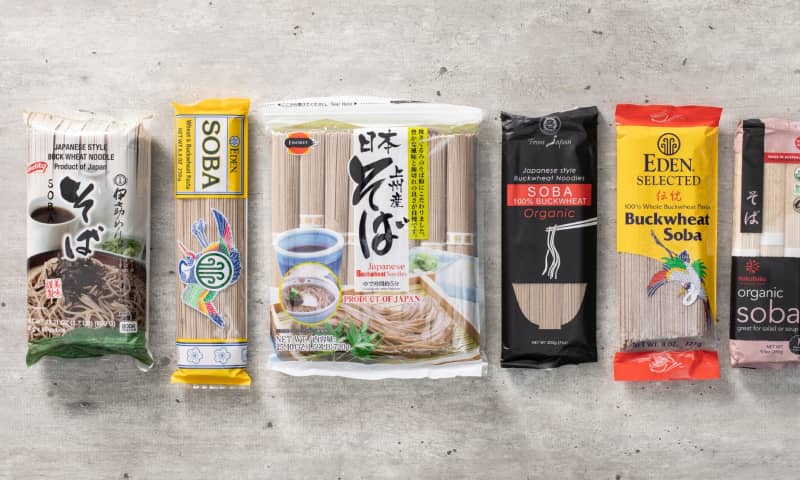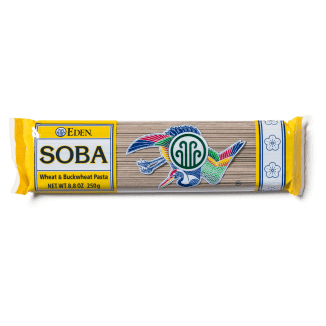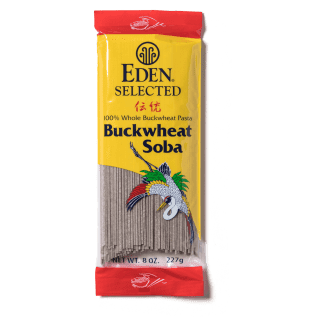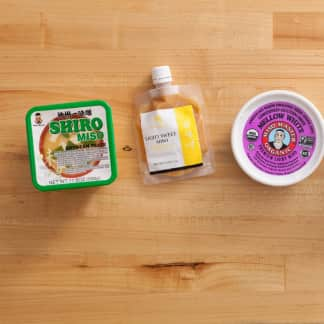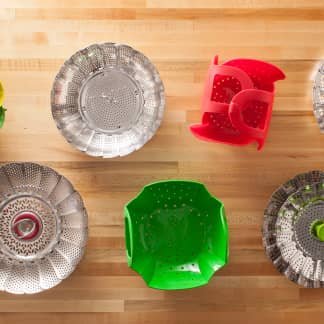Soba noodles have been an important part of Japanese cuisine since they were first developed in the country in the late 1500s or early 1600s. It’s traditional to eat soba on New Year’s Eve and to gift soba to new neighbors because, among other things, the long, slim noodles are thought to bring good luck and a long life. But they’re not just for special occasions. Japan has tens of thousands of soba shops—from elegant, formal restaurants to casual spots. You can even buy soba noodles from vending machines. It’s easy to see why these buckwheat noodles are so popular: They’re hearty and slightly chewy, with a delicate earthy, nutty flavor. In the summertime, soba noodles are refreshing when served chilled with a dipping sauce or cold broth. And in colder weather, these noodles form the foundation for comforting, satisfying hot soups. We love them both in time-honored Japanese recipes and in some nontraditional applications, such as soba noodle salads.

Dried soba noodles are easy to find in Asian markets, in many grocery stores, and online. Which ones should you buy? To find out, we purchased six kinds of dried soba noodles, priced from about $3 to about $9 per package, and sampled them in two blind tastings. First, we ate them plain, sampling them with a side of traditional tsuyu, a Japanese dipping sauce made by combining dashi and a soy sauce, mirin, and sugar mixture called kaeshi. Next, we sampled them in a salad with vegetables.
Some Soba Noodles Contain Wheat Flour
Traditional dried soba noodles have just two ingredients: buckwheat flour and water. Buckwheat flour contains no gluten, the protein that gives wheat‑based doughs their elasticity. As a result, doughs made with buckwheat flour are delicate and the noodles tend to be more fragile than noodles that contain a blend of buckwheat flour and wheat flour. Two of the noodles in our lineup were made from 100 percent buckwheat flour, while four were made from a blend of buckwheat and wheat flours.
Let’s cut to the chase. The presence of wheat flour changes both the flavor and the texture of the noodles. While we liked every product we tasted, they were very different. The noodles made from buckwheat flour tasted deeply earthy, nutty, and faintly sweet. That big buckwheat flavor stood out even when the noodles were tossed with a bold dressing and vegetables in a salad or dipped in tsuyu. Tasters liked that the “toasty buckwheat flavor” was “pronounced” and “came through with each bite.”

Conversely, noodles made from a blend of buckwheat and wheat flours tasted milder because the addition of wheat flour tempered the buckwheat’s intensity. The exact ratio of flours isn’t typically listed on the packaging, but most of the manufacturers were willing to share that information with us. Among the blended noodles, the overall top scorer was made with 20 percent wheat flour and 80 percent buckwheat, a formulation known as nihachi style (ni means “two” and hachi means “eight”). We also gave high marks to a blend made with 40 percent buckwheat flour. One soba noodle made with just 30 percent buckwheat was so mild that it risked being mistaken for spaghetti.
For the most part, the textures of the noodles corresponded with their flavors and colors. The noodles that contained the highest percentages of buckwheat flour were fragile and prone to clumping during cooking, so we had to stir them very gently and handle them carefully. These noodles had the strongest flavors and were firm, chewy, and dark brown in color once cooked. The noodles with lower percentages of buckwheat flour were more tender and more resilient, thanks to the gluten from the wheat. They were also less assertively flavored and not as dark. Tasters loved their “really good chew” and “springy texture.”
What Exactly Is Buckwheat?
Although the name implies otherwise, buckwheat isn’t actually a type of wheat. Rather, it’s a cousin of both rhubarb and sorrel and is referred to as a pseudocereal, a category of plants that have culinary uses and nutritional profiles very similar to cereal grains such as rice and wheat. It produces pyramid-shaped seeds, or groats, that are roasted and then cooked whole (called kasha), cracked (so they’re similar to grits), or milled into a flour.
Buckwheat was consumed in Japan in the form of porridge or dumplings for centuries before the first soba noodles were made. According to Sonoko Sakai, a California-based cooking teacher and author of several Japanese cookbooks, soba noodles are especially significant in Japanese cuisine because they are native to the country. (Ramen noodles originated in China, as did the techniques for making somen and udon.) Soba noodles were likely first made in temples and quickly caught on with the general population, especially when they proved to be an affordable, convenient meal for laborers building the new capital city, Edo, now Tokyo. The word soba means both “buckwheat” and “noodle.”
Do Soba Noodles Need Salt?
As with traditional Italian pastas, traditional soba noodles don’t contain added salt. The cooking water isn’t salted either. The reason? Many of the broths and sauces paired with soba use dashi, the umami broth made from kombu (seaweed) and bonito (dried fish flakes), and often contain soy sauce, both of which are fairly salty. Our lineup was split: Three of the noodles contained added salt and three didn’t. Though the noodles made in the traditional way, sans salt, also scored well with our tasters, two of the salted products, with sodium contents of about 400 to 500 milligrams per 2-ounce serving, were our favorites. The other salted product contained more than 900 milligrams of sodium per 2-ounce serving and was a little too salty. A moderate amount of salt probably helped bring out the flavors of other ingredients without making the dishes taste overly salty.
How To Shop For Soba Noodles
We think soba noodles deserve a place in your pantry. Like other dried pastas, they’re relatively inexpensive and very convenient. They cook in a matter of minutes and form the foundation for wonderful chilled and hot dishes. Our tasters liked the noodles made from buckwheat, but products made with a blend of 40 to 80 percent buckwheat flour were more broadly appealing to our tasters. We especially liked Shirakiku Soba Japanese Style Buck Wheat Noodle, a product which had a “pleasing but mild buckwheat flavor” and a firm, bouncy texture. These noodles scored top marks both when served plain and in the salad. If you can’t find this brand, we suggest looking for another blended product that’s fairly dark in color, a sign that generally indicates the presence of a higher ratio of buckwheat flour.
- Made with blend of wheat flour and at least 40 percent buckwheat flour
- Balanced earthy, nutty, and faintly sweet flavor
- Firm, bouncy, springy texture
- Contains moderate amount of sodium so dishes taste flavorful but not too salty
- Taste plain with traditional dipping sauce (tsuyu)
- Taste in Chilled Soba Noodles with Cucumber, Snow Peas, and Radishes
